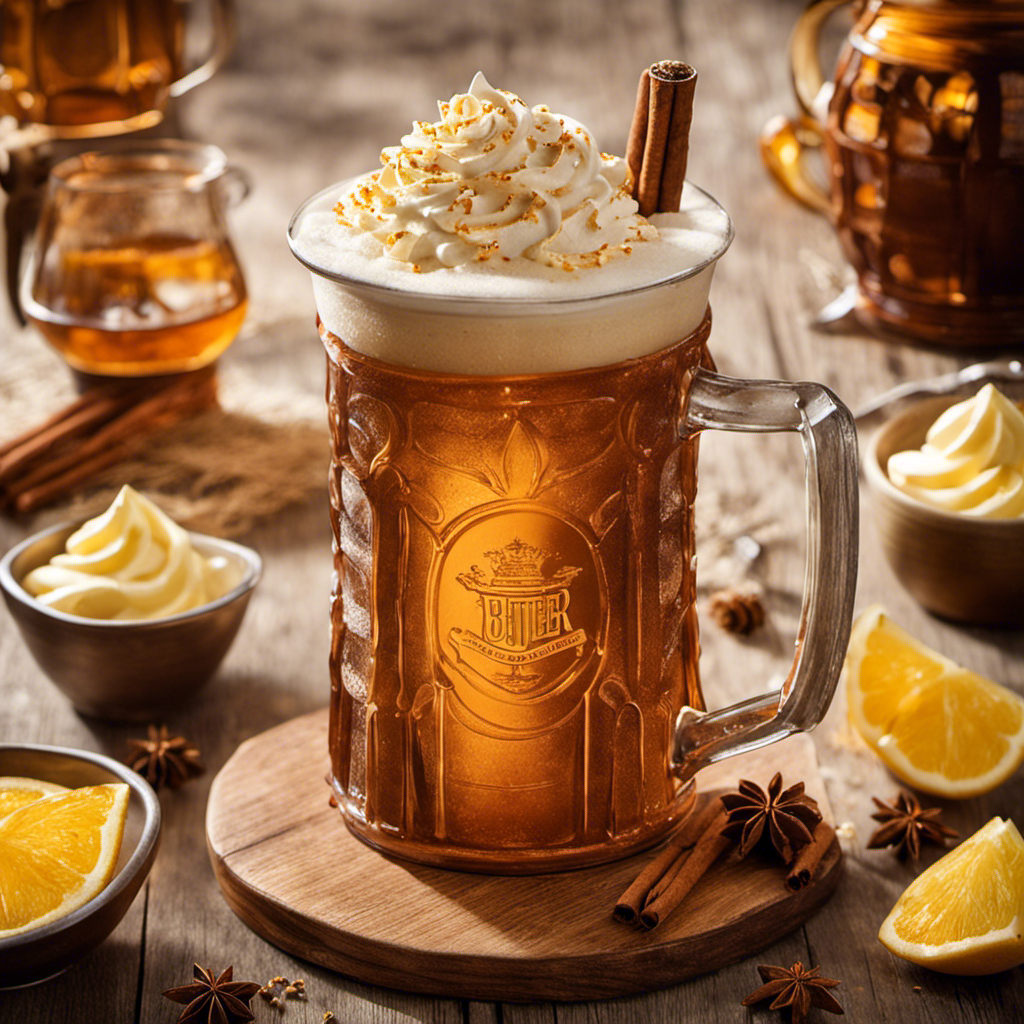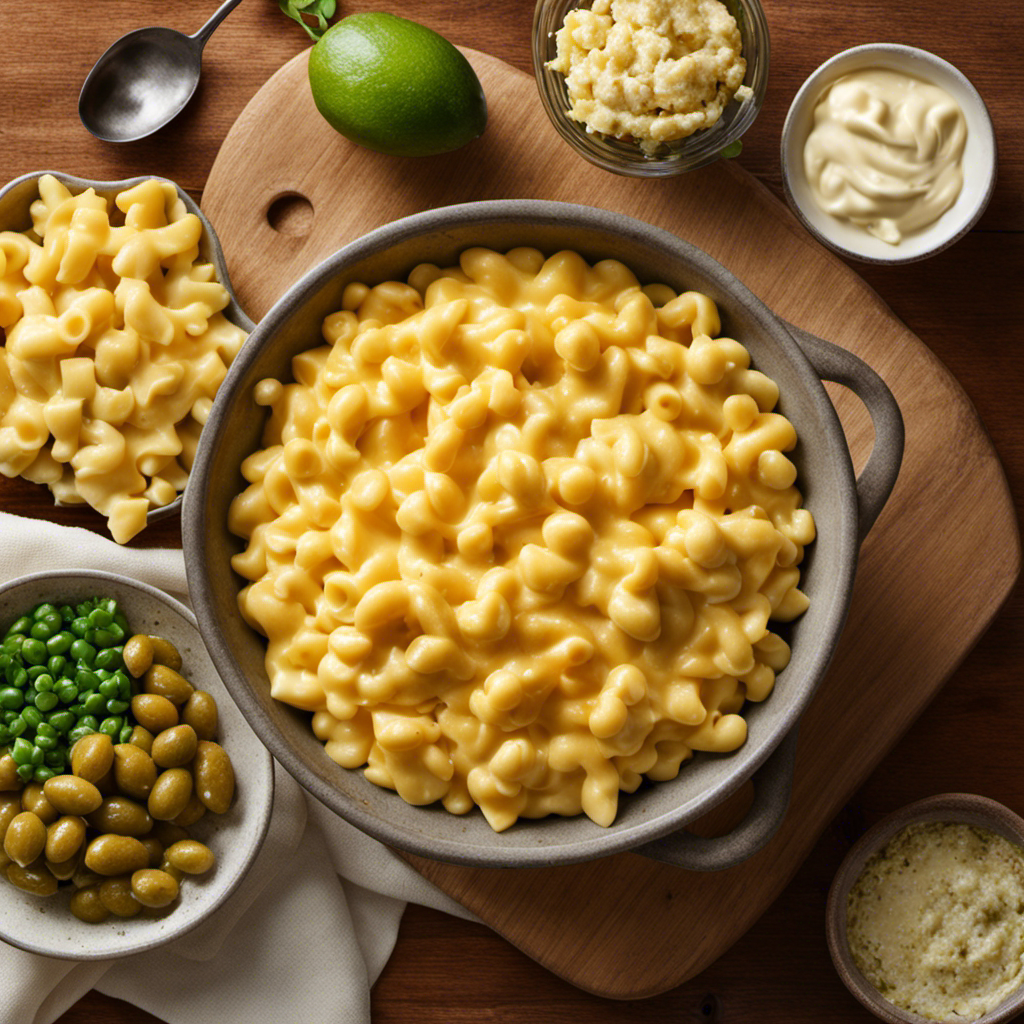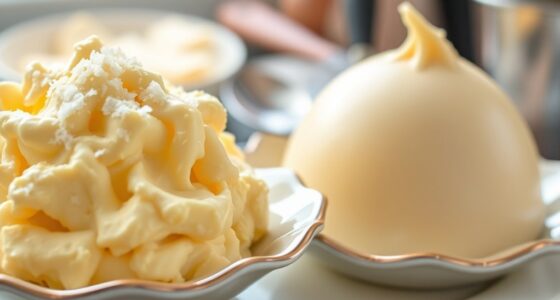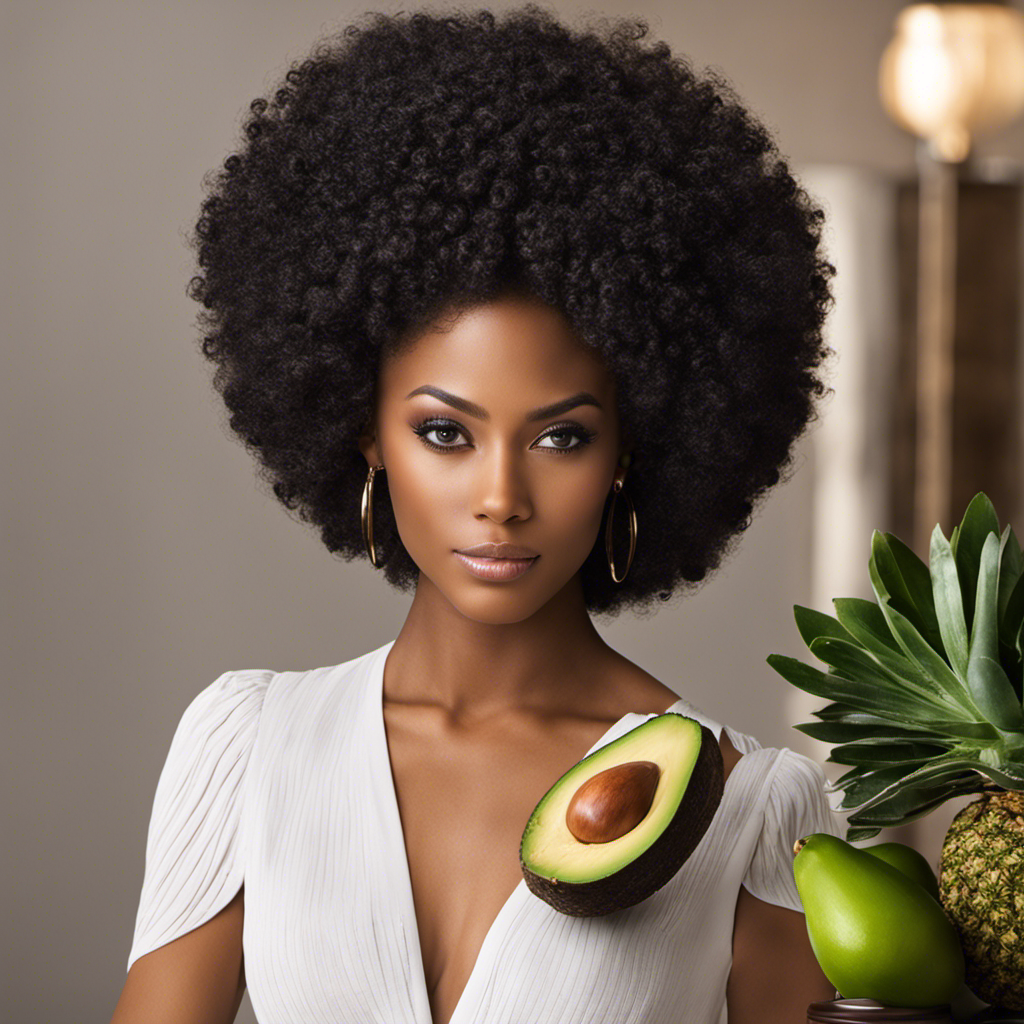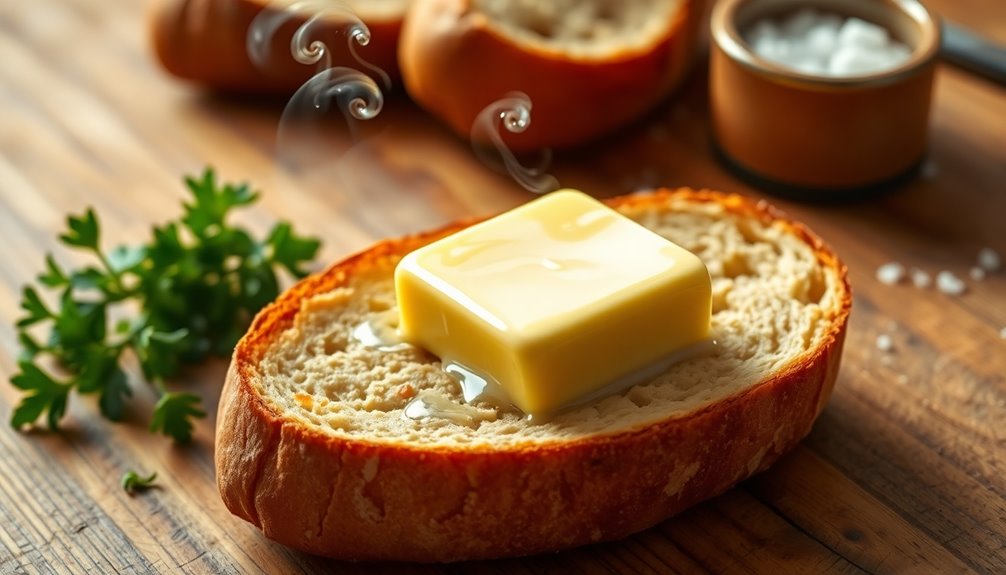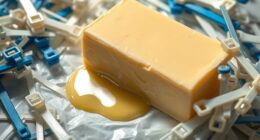When I first tried butter beer, a perfect combination of flavors danced on my tongue. The rich caramel tones mixed with a hint of butterscotch, creating a smooth sweetness that brought back feelings of nostalgia and comfort.
The smooth, creamy texture enveloped my palate, leaving a lingering warmth that reminded me of cozy evenings by the fireplace. With each sip, I discovered a new layer of complexity, a testament to the artistry behind this beloved beverage.
Join me on a delightful journey as we explore the enigmatic taste of butter beer.
Key Takeaways
- Butter beer has a rich and creamy texture with a unique taste due to precise measurements and techniques used in its brewing process.
- The secret flavor ingredients of butter beer, such as butterscotch syrup, cream soda, and vanilla extract, create a sweet and creamy beverage with hints of butterscotch.
- Traditional recipes of butter beer focus on warm and comforting flavors, while modern recipes introduce unexpected flavors like lavender or chili pepper.
- Butter beer can be enjoyed in various forms, including adding a scoop of vanilla ice cream for a creamy twist or serving it frozen as a delightful treat for hot summer days.
Origins of Butter Beer
Butter beer is a popular fictional beverage in the Harry Potter series. Its origins can be traced back to the wizarding world, where it has been enjoyed for centuries. The brewing process of butter beer is a closely guarded secret, known only to a select few in the wizarding community.
However, it is believed that the drink is made by combining a variety of ingredients, including butterscotch, cream, and a touch of magic. The precise measurements and techniques used in the brewing process are what give butter beer its unique taste and texture.
As we delve into the subsequent section about the ingredients of butter beer, we will uncover more about this delightful and enchanting beverage.
Ingredients of Butter Beer
When it comes to the world of butter beer, there are several intriguing aspects to explore.
One of the most fascinating elements is the use of secret flavor ingredients that give this beloved beverage its unique taste.
Additionally, it is interesting to compare and contrast traditional and modern recipes to understand how the drink has evolved over time.
Secret Flavor Ingredients
The secret flavor ingredients in butter beer create a unique and delicious taste. When it comes to butter beer, there are a few key ingredients that contribute to its distinct flavor profile.
The first secret ingredient is butterscotch syrup, which adds a rich and sweet caramel-like taste to the drink. This is then combined with cream soda, which provides a creamy and fizzy base.
Another secret ingredient is vanilla extract, which adds a subtle yet essential flavor note to the beverage. The combination of these ingredients creates a delightful balance of sweetness and creaminess that is synonymous with butter beer.
As we explore the traditional and modern recipes for butter beer, it is interesting to see how these secret ingredients are used in different ways to achieve various flavor profiles.
Traditional Vs. Modern Recipes
If you’re curious about the difference between traditional and modern recipes for butter beer, you’ll find that each version offers its own unique twist on this beloved beverage.
Here’s a breakdown of the key differences:
-
Traditional techniques: Traditional recipes for butter beer often involve simmering a mixture of butter, sugar, and spices to create a rich and creamy base. This method lends a warm and comforting flavor to the drink.
-
Modern techniques: Modern recipes, on the other hand, often incorporate innovative techniques such as foams, infusions, or molecular gastronomy. These techniques add a touch of creativity and playfulness to the classic drink.
-
Unique flavor combinations: Both traditional and modern recipes experiment with different flavor combinations. Traditional recipes usually focus on warm and comforting flavors like cinnamon, nutmeg, and vanilla. Modern recipes, on the other hand, may introduce unexpected flavors like lavender, caramelized white chocolate, or even chili pepper.
-
Overall, whether you prefer the comforting nostalgia of a traditional butter beer or the adventurous flavors of a modern twist, there’s no denying that both versions offer a delightful and magical experience.
Popular Variations and Twists
To really elevate your butter beer experience, you should try adding a scoop of vanilla ice cream for a creamy and indulgent twist. This unique recipe adds a whole new dimension to the flavors and pairings of butter beer.
The smooth and rich vanilla ice cream complements the buttery, caramel-like taste of the drink, creating a delightful combination that is both refreshing and satisfying. The coldness of the ice cream also adds a refreshing element to the warm and comforting butter beer, making it a perfect treat for any time of the year.
Whether you’re a fan of the Harry Potter series or just looking for a delicious and unique beverage to enjoy, this butter beer with a scoop of vanilla ice cream is sure to satisfy your taste buds and leave you craving for more.
Brewing Process of Butter Beer
During the brewing process, the butter beer takes on a rich and creamy texture. It is a magical concoction that requires precise brewing techniques to achieve the perfect balance of flavors.
Here are four key steps in the brewing process that contribute to the unique taste of butter beer:
-
Fermentation: The base ingredients, such as malt and yeast, undergo a fermentation process to convert sugars into alcohol. This step adds complexity and depth to the flavor profile.
-
Infusion: Various herbs and spices, like vanilla and cinnamon, are infused into the mixture to create a warm and aromatic taste. These flavors complement the richness of the butter.
-
Carbonation: The beer is carbonated to give it a refreshing fizziness. This adds a delightful effervescence to the creamy texture.
-
Sweetening: Traditional butter beer recipes use brown sugar or butterscotch syrup to provide a sweet and caramelized taste. However, alternative recipes may use honey or maple syrup for a different twist.
Flavors and Notes in Butter Beer
When it comes to the flavors and notes in Butter Beer, there are two key points that stand out: it is sweet and creamy, with hints of butterscotch.
The combination of these elements creates a delicious and indulgent taste experience. The sweetness and creaminess give the drink a smooth and velvety texture, while the hints of butterscotch add a warm and caramel-like undertone.
Sweet and Creamy
You’ll love how sweet and creamy butter beer tastes on your first sip. It’s a magical experience that transports you straight to the wizarding world of Harry Potter.
Here are four reasons why butter beer is an irresistible treat:
-
Rich and Butterscotch-Flavored: The combination of butter, sugar, and butterscotch syrup creates a delightful sweetness that lingers on your palate.
-
Frothy and Creamy Texture: The addition of cream soda and whipped cream gives butter beer a velvety smoothness that adds to its indulgent appeal.
-
Warm and Comforting: Served hot or cold, butter beer provides a cozy, comforting feeling that makes it the perfect drink to enjoy on a chilly day or while snuggled up with a good book.
-
Versatile: Butter beer can be enjoyed in various forms, including as a base for cocktails or even in vegan versions, ensuring that everyone can savor its delectable flavors.
Whether you’re a Harry Potter fan or simply looking for a delicious and unique beverage, butter beer is a must-try treat that will leave you craving more.
Hints of Butterscotch?
In my quest to describe the taste of butterbeer, I can’t help but wonder if there are hints of butterscotch in this magical concoction. As I took my first sip, I was immediately greeted by a wave of sweetness that danced on my tongue.
The creamy texture enveloped my senses, but there was something more. As the flavors mingled, a distinct note of butterscotch emerged, adding depth and complexity to the overall experience. It was as if I could taste the warmth of caramelized sugar and the richness of butter all at once.
The hints of butterscotch added a delightful sweetness that balanced perfectly with the creaminess of the beverage, creating a truly enchanting flavor that I couldn’t get enough of.
Texture and Consistency of Butter Beer
To get a sense of the texture and consistency of butter beer, take a sip and feel the smooth and creamy blend on your palate. It’s like a velvety potion that coats your mouth with a luxurious sensation.
The texture is thick and luscious, almost like melted ice cream. As you drink, you’ll notice a gentle carbonation that tickles your taste buds, adding a bit of effervescence to the overall experience.
Here are four key characteristics that define the texture and consistency of butter beer:
- Creamy: The beverage has a rich and indulgent creaminess that is reminiscent of a milkshake.
- Silky: It glides effortlessly across your tongue, leaving behind a silky smoothness.
- Frothy: The carbonation creates a light and frothy layer on top, making each sip feel like a small celebration.
- Decadent: The combination of the velvety texture and the sweet flavors creates a truly decadent treat that is hard to resist.
Overall, the texture and carbonation of butter beer contribute to its irresistible allure, making it a delightfully indulgent and magical drink.
Serving Suggestions for Butter Beer
For a fun twist, try serving butter beer in a chilled frosted mug to enhance its refreshing qualities. The serving temperature can make a significant difference in the overall experience of this delightful beverage.
Another unique twist is to add a dollop of whipped cream on top, sprinkled with a pinch of cinnamon or nutmeg for added flavor and visual appeal. This not only adds a touch of elegance but also enhances the creaminess of the drink.
For those looking to add a bit of a kick, a splash of rum or bourbon can be a great addition to the traditional recipe. These serving suggestions can elevate the taste and presentation of butter beer, making it a memorable drink for any occasion.
Now, let’s delve into the historical significance of butter beer.
Historical Significance of Butter Beer
Imagine yourself transported back in time to the wizarding world, where butter beer originated and held a special place in magical history. This delicious concoction has deep historical origins and cultural significance. Here are four fascinating facts about the historical significance of butter beer:
-
Ancient Origins: Butter beer can be traced back to the early days of wizarding civilization, where it was believed to have been first brewed by ancient wizards. Its recipe has been passed down through generations, making it a true wizarding tradition.
-
Symbol of Celebration: Butter beer has long been associated with celebrations and special occasions. It was often served during festivals, weddings, and other joyous events, symbolizing abundance and good fortune.
-
Magical Properties: According to wizarding lore, butter beer possesses magical properties that can enhance one’s mood and bring about feelings of warmth and comfort. It is said to have a calming effect on the drinker, making it a popular choice for those seeking solace.
-
Cultural Icon: Butter beer has become a cultural icon in the wizarding world, representing unity and camaraderie. It is often shared among friends and loved ones, fostering a sense of community and connection.
Popular Variations of Butter Beer
One of the most popular variations of butter beer is the frozen version. It adds a refreshing twist to this beloved wizarding beverage.
The frozen butter beer takes the traditional flavors of butter, cream, and butterscotch. It transforms them into a delightful frozen treat.
The unique flavor profiles of this icy concoction are truly enchanting. As you take a sip, you are greeted with a sweet and creamy taste. It is reminiscent of caramel and vanilla.
The smooth texture and coolness of the drink make it perfect for hot summer days. It is also a special treat any time of the year.
What’s great about the frozen butter beer is that it can be enjoyed by all. This includes those who prefer non-alcoholic alternatives.
Frequently Asked Questions
How Many Calories Are in a Serving of Butter Beer?
The caloric content and nutritional value of a serving of butter beer vary depending on the recipe. However, it is generally a sweet and creamy beverage, reminiscent of butterscotch and caramel flavors, with a hint of vanilla.
Can I Make Butter Beer at Home Using Common Ingredients?
Sure, I can make butter beer at home using common ingredients. There are various recipe variations, but they typically include butter, sugar, cream soda, and optional spices like cinnamon. The ingredients also offer health benefits, like the soothing effects of butter and the antioxidant properties of spices.
Are There Any Vegan or Dairy-Free Options for Butter Beer?
There are vegan alternatives and non-dairy substitutes available for making butter beer. These options ensure that individuals who follow a vegan or dairy-free lifestyle can still enjoy the taste and experience of this popular beverage.
Is Butter Beer Alcoholic?
Butter beer is not alcoholic. It is a non-alcoholic beverage that originated in the wizarding world. However, it can be served hot or cold, and it is gluten-free, making it accessible to a wide range of people.
Can Children Drink Butter Beer?
Butter beer is safe for children to consume and there are no health concerns. It tastes like a creamy, sweet, and slightly butterscotch-flavored drink. Alternative non-alcoholic beverages for children with a similar taste include cream soda or caramel apple cider.
Conclusion
In conclusion, after delving into the origins, ingredients, brewing process, flavors, and historical significance of Butter Beer, it is clear that this beverage holds a mystique that cannot be easily dismissed.
The combination of sweet and buttery notes, along with a creamy and frothy texture, creates a sensory experience unlike any other. Whether enjoyed warm or cold, alone or with friends, Butter Beer is a beverage that transports you to a world of enchantment.
Its popularity has sparked numerous variations, leaving us eager to explore the limitless possibilities of this magical elixir.
